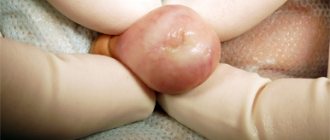Reactive psychosis is a temporary and reversible mental disorder, psychotic level, resulting from exposure to severe mental trauma. It is similar to other psychoses, but has more pronounced lability, variability and affective intensity.
The general concept of “psychoses” (psychotic disorders) is understood as manifestations of mental illnesses in which a person’s mental activity distorts the surrounding reality in consciousness, which can manifest itself in various disorders of behavior, consciousness, and the presence of pathological syndromes and symptoms.
Reactive psychosis can be characterized by the Jaspers triad, the signs of which are as follows:
• Clinical symptoms reflect a traumatic event; • Mental disorders arise under the influence of a traumatic event; • Mental disorders disappear after the end of the event.
But Jaspers' triad is not a universal remedy. Mental disorders do not always occur immediately after a traumatic event (delayed reactions) and tend to persist for a long time after the cessation of the psychic trauma.
However, not all mental disorders that arise under the influence of mental trauma can be classified as reactive psychoses. Schizophrenia, bipolar disorder, presenile psychosis and many other diseases can be triggered by mental trauma.
Classification of reactive psychoses
In accordance with ICD-10, reactive psychosis can be observed in the following conditions: • acute and transient disorders (F23);
• depressive episode (F32); • acute reaction to stress (F43); • post-traumatic stress disorder (F43.1); • adaptation disorders (F43.2); • dissociative (conversion) disorders (F44). There are many forms of reactive psychoses. Various psychopathological syndromes alternate or predominate. The course of the disease is wavy, the duration varies depending on the initial state of a particular person and the form of psychosis.
The group of reactive psychoses can also be replenished with psychotic states, which represent one of the stages in the development of post-traumatic stress disorder
There is no generally accepted classification of reactive states, but from the point of view of clinical manifestations, several forms can be distinguished:
1. acute reaction to stress (affective-shock reaction) 2. hysterical psychoses 3. psychogenic depression 4. psychogenic mania 5. psychogenic paranoids
You can also classify according to the duration of exposure to the traumatic event:
Protracted reactive psychoses. Develops in a person with prolonged exposure to a traumatic situation (delusions, obsessive states, depression). Subacute. Occurs after exposure to psychological trauma (reactive depression, hysterical psychosis, paranoid states) Acute. Appears immediately after a traumatic event.
Who will help?
There are several degrees of the disease, the mildest of which is called “hypomania.” People with this diagnosis are often considered very active, active, sociable, and often the syndrome is not even noticed. The whole point is that only an experienced specialist can give an assessment, so as not to accuse an innocent person of anything.
People with manic syndrome often look much younger than they actually are, this effect is created by:
- animated facial expressions;
- fast speech;
- sudden movements;
- sociability;
- activity.
If the syndrome is not recognized at this stage, then it can give way to severe depression or all the symptoms become much deeper, and delusions of grandeur appear.
After manic syndrome has been diagnosed, the psychologist suggests acting comprehensively, using psychotherapy and medications. Another nuance of this disease is that the causes of its occurrence need to be eliminated. As a rule, the disease is accompanied by several other diseases. Possible:
- psychoses;
- neuroses;
- depression;
- obsessive fears.
These are not all the problems that can accompany manic syndrome.
Causes of reactive psychoses
This is a traumatic situation that has a strong stressful effect on a person.
The situation may pose a threat to life or well-being and is associated with character traits, environmental conditions, and beliefs. Reactive psychoses can occur during accidents, catastrophes, natural disasters, losses, imprisonment or the threat of legal liability, etc. In the appearance of reactive psychoses, an important role is played by the initial functional state of the central nervous system (CNS), the personal characteristics of the patient before the onset of the disease, the typological properties of his nervous system. All factors combined make a given person more (prone) vulnerable to the occurrence of mental trauma.
Why does it occur?
Two factors come into play here:
- genetic predisposition;
- constitutional factor.
People with manic syndrome often have inflated self-esteem and self-esteem. They often overestimate their talents and capabilities. Some of them can be persuaded by showing your own example, but many remain unshakable.
Pathogenesis
As a result of psychotrauma, inhibition occurs in the cerebral cortex and its subcortical structures.
The specific clinical form of psychosis depends on the spread of inhibition. In acute and prolonged psychoses, the main pathogenetic factor is the pathodynamic structures responsible for the extent of inhibition in the cerebral cortex. In this case, the main neuroassociative stream is involved in a given point of the cortex and remains fixed there. This is the mechanism of one of the main symptoms of reactive states - the pathological fixation of patients’ attention on traumatic thoughts. In psychogenic stupor, inhibition from the pathodynamic structure is concentrated in the motor (cortical and subcortical) parts of the brain, when, for example, in hysterical psychoses (with impaired consciousness) pathological excitation appears in them.
The experiences of patients with reactive psychoses depend on the functional ability of the pathodynamic structure itself. When it is fixed in pathological arousal, patients are reliably fixed on psychotraumatic circumstances; and vice versa, in the presence of phase states, patients experience psychotrauma in a positive way for themselves, as is observed in some psychogenic twilight states and delusional fantasies.
When the pathodynamic structure transitions into an inhibitory state, patients “forget” everything that is directly or indirectly associated with psychotrauma and even the fact of its presence (the mechanism of affectogenic amnesia in delusional fantasies, pseudodementia, puerilism, etc.).
Reactive paranoid syndrome, in the cerebral cortex, causes a number of isolated from each other, but associated with the pathodynamic structure of the diseased points in the cerebral cortex, which determines the psychogenic content of their specific delusional ideas in these patients. In subacute paranoid reactive psychoses and in cases of psychogenic delusional psychosis, in the cerebral cortex there is a functionally isolated single powerful pathodynamic neuroassociative structure in a state of inert excitation, switching over the main neuroassociative flow.
The differences in the clinical picture and further course of the disease are determined by the fact that the paranoid reaction is formed under the influence of acute psychotrauma on the basis of any phenotype of the nervous system, while in psychogenic paranoid delusions the pathodynamic structure is formed under conditions of chronic psychotraumatization on the basis of an initially inert phenotype of the nervous system - paranoid psychopathy.
Symptoms of reactive psychosis
1. Shock psychogenic reactions (shock neuroses, affective-shock reactions, emotional neuroses)
Psychosis occurs due to a sudden strong emotional shock or a life-threatening situation (accident, catastrophe, etc.), all of which can be associated with situations of a negative nature. Affective shock psychoses can manifest themselves in two forms: psychomotor retardation and psychogenic motor agitation. Psychomotor retardation with mutism. The disease manifests itself as complete immobilization and the inability to establish speech contact. The patient is unable to move or call for help, even in a potentially dangerous situation. In this condition, the patient is in clear consciousness, perceives events around him, but does not react to what is happening. Psychogenic motor agitation begins acutely, in the presence of psychotrauma. General psychomotor agitation occurs, the patient is restless, makes aimless movements, speech is usually slurred, and a grimace of horror or fear may be expressed on the face. Impaired consciousness is present.
2. Hysterical psychoses (psychogenic twilight states)
Hysterical psychoses are a common type of reactive states.
They are characterized by symptoms of any type of clouding of consciousness (disorientation, no reaction to events occurring around them, disruption of object contact, etc.). Clouding of consciousness can be traced to a connection with mental trauma. Hysterical psychoses are often divided into three types: pseudodementia, puerism, and hysterical twilight stupefaction. Pseudo-dementia
- the patient suddenly becomes “stupid”, cannot solve the simplest problems, gives ridiculous answers, and is disoriented.
Ganser syndrome is a type of pseudodementia that affects people in prison. Puerilism
is characterized by regression of the psyche to the level of a child.
The form of speech, behavior, emotional reactions become similar to children's. This clinical picture may include elements of adult behavior. Hysterical twilight states
occur in persons with hysterical psychopathy. Patients are demonstrative and can act out scenes in which there is a connection with psychotrauma. There is a perception disorder (true hallucinations), the statements are delusional, they also reflect the traumatic situation suffered.
3. Psychogenic depression (reactive depression)
Psychogenic depression is the most common form of reactive states. It is characterized by: decline in mood, feeling of depression, the patient is careless, stops taking care of himself. As depression deepens, depressive delusions (constant feelings of guilt) and often suicidal thoughts appear. The main cause of anxiety is the psychological trauma that caused the disease. The course is wavy, relative to the severity of symptoms. In clinical practice, there are three more variants of reactive depression: asthenic, depressive-delusional, hysterical psychogenic.
4. Psychogenic manias
Psychogenic manias are much less common than other reactive states. The cause of occurrence is sudden severe psychotrauma that causes a state of passion. A predisposing factor to psychogenic mania may be the presence of psychopathy of the affective and hysterical type, or schizotypal personality disorder. The clinical picture is characterized by irritability, fussiness, increased activity, and unreasonable joy. There is often a combination of opposing emotions present. A sleep disorder occurs (insomnia, restless sleep, difficulty falling asleep, shortened sleep time) associated with replaying memories of traumatic events. The patient is energetic and strives to do everything possible to improve his traumatic situation. At the peak of affect, productivity is lost, hyperactivity, importunity, and conflict come to the fore. The delirium of litigiousness and the desire to punish those “culpable” in the event may join.
5. Psychogenic paranoids
(reactive paranoid, psychogenic paranoid delusional formation, induced delusion) Reactive paranoid develops as a result of an unfavorable situation for the patient, there is a delusional belief that he is being watched, everyone around him is an enemy, treats him badly and wishes harm, etc. Auditory hallucinations often appear, which confirm the patient's beliefs. The development of an acute condition occurs after a short preceding period, with a feeling of anxiety, fear that something bad is about to happen. Psychotraumatization occurs after a new, unusual situation for the patient, combined with external impressions that create an atmosphere of anxiety, uncertainty, and anxiety.
Psychogenic paranoid delusional formation
- a type of reactive psychosis, does not have an acute onset, develops over a long period of time and gradually develops (sometimes several years). The disease is more common in individuals with paranoid psychopathy. Development occurs in conditions of chronic psychotraumatization. The delusion is systematized, based on the interpretation of real events and the situation surrounding the patient. With a prolonged course, delirium becomes persistent and persists for many years.
The patient loses the ability to work and care for himself. Memory, intelligence, adequacy and expression of emotions are not affected.
Induced delusion manifests itself in the “transition” of mental disorders from one person to another. Such a transition is observed in conditions of close communication between several individuals, while one of the individuals suffers from psychosis and is the source of induction - the inducer. A person who perceives these disorders is called inducible.
There are a number of conditions that promote psychic induction:
• close communication (cohabitation, common work or personal relationships) of the inducer and the inducible • the initial mental superiority of the inducer over the inducible (intellectual, social or characterological) • mental weakness, suggestibility of the inducible Themes of induced psychoses are most often associated with delusions of persecution, jealousy, and litigiousness.
Types of manic syndrome
As mentioned earlier, the disease has degrees of complexity and varieties. The following types are distinguished:
- Manic-paranoid.
- Oneiric mania.
- Crazy option.
- Joyful mania.
- Angry mania.
While the last three points are somewhat clear to the average reader, the first two require some explanation.
- The manic-paranoid degree manifests itself in relationships. Such people are capable of pursuing the object of their passion, and delusional ideas appear in relation to their partner.
- Oneiric mania. At the peak of the syndrome, hallucinations occur, a very serious and severe degree of manic syndrome, but, like all others, it is treatable.
If we consider the delusional version, the patient builds a logical sequence of delusional ideas, as a rule, all this concerns the professional level.
The next two types are the complete opposite: in the first case there is increased activity, in the second - short temper, anger, and conflict.
Diagnosis of reactive psychoses
It is important to carry out a differential diagnosis; the symptoms of reactive psychoses are similar to the symptoms of diseases such as schizophrenia, manic-depressive psychosis, delusional disorders, endogenous and psychogenic depression, drug or alcohol intoxication, etc. The diagnosis is made based on the medical history, anamnesis, clinical picture, presence traumatic event and the connection of symptoms with psychotrauma. For example, reactive depression differs from the first depressive phase of circular psychosis (which has a psychogenic onset) in that patients are fixated on traumatic thoughts rather than on their own personality, while the patient justifies melancholy and suicidal thoughts with traumatic events.
Manic. Test
You can take it from an experienced psychologist, but a simplified (at-home) version is also possible. You shouldn’t worry too much before taking the test; manic thinking is a kind of deviation from the norm; if it doesn’t cross the line of what’s acceptable, then you shouldn’t focus on it.
What questions might you get on this test? Examples of them are the following:
- Was my mind sharper than ever before?
- Have you been sleeping much shorter than usual?
- Was the distraction due to the mass of ideas that kept coming into my head?
- Do I feel an eternal need for communication?
- Did I have a feeling of boundless happiness?
- Has my activity level been increased?
These are not all possible questions. It is worth considering the fact that when answering, you need to take into account the whole week, and not just the last two or three hours. Mania is not a death sentence; this disease is completely curable.
Course of the disease, prognosis
Psychosis usually develops within a few hours of psychological trauma.
The duration of psychosis ranges from several hours to several months, but this time may vary. Psychogenic motor excitation has a short course, the output is acute with restoration of orientation, but with amnesia for the period of psychosis. Psychomotor retardation with mutism also has an acute outcome and is accompanied by brief asthenia. The way out of reactive depression is initially lytic, but from the moment the condition improves, there is a tendency to wave-like changes in the severity of symptoms. In general, the duration of the disease ranges from several weeks to 2-3 months. Reactive paranoid can last from several days to several months and depends on how much the traumatic situation has disappeared.
With effective therapy, the prognosis of the disease is favorable. Treatment and its duration are determined by the mobility of symptoms, the good initial (before the disease) condition of the patient, the duration of symptoms, as well as the presence of cases of mental disorders in heredity. It should be remembered that reactive psychoses can also occur in patients with a history of chronic mental illnesses. In this case, the symptoms may be influenced by the underlying psychopathological condition.
How to recognize the disease
Signs of mania vary, but the most common are the following:
- Megalomania.
- Crazy ideas.
- Reassessing your capabilities.
- An obsession with protecting oneself.
- Sexuality increases.
- Appetite increases.
- Distractibility appears.
Mania is a mental disorder that requires special attention. A psychological test that can be done at home will help you understand whether you are susceptible to this disease.
Treatment of psychosis at the Alter Clinic
Treatment of reactive psychoses in patients is currently carried out by a large system of medication, psychotherapeutic and social techniques.
To be effective, all treatment methods must be in balance with each other, taking into account the clinical form of the reactive state and the type of its treatment. In the presence of an acute condition, treatment is carried out inpatiently. At the clinic of Dr. Shmilovich “Alter” it is possible to undergo a course of individual pharmacotherapy, psychotherapy, incl. cognitive-behavioral, which will help you get rid of attitudes that have arisen against the background of the disease and receive the necessary recommendations. Only highly qualified specialists work. Each psychologist and psychiatrist has extensive experience in this field and constantly improves their qualifications.
Our specialists use the most modern techniques with proven effectiveness to achieve the desired result. The specialist finds an individual approach to each patient. Also, any of your calls to our clinic will remain anonymous.
Fixed price for each individual service. You can find prices and a list of services on our website Convenient location. Our clinic is located in the center of Moscow, near the Cathedral of Christ the Savior, on Vsevolozhsky Lane, next to the Kropotkinskaya metro station.
If you find yourself in a difficult situation, we will provide you with qualified assistance, high quality and at an affordable price. Finding a solution to the problem is much easier if you contact a specialist as early as possible. Our goal is your recovery.






